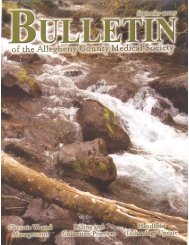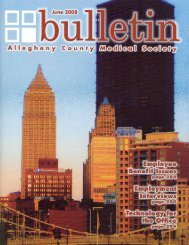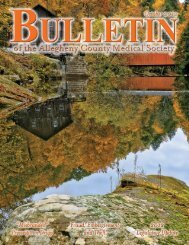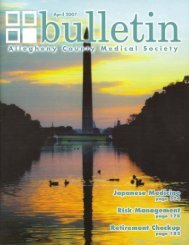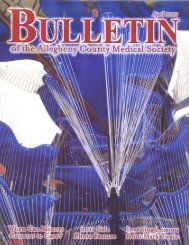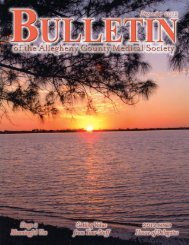bulletin - Allegheny County Medical Society
bulletin - Allegheny County Medical Society
bulletin - Allegheny County Medical Society
- No tags were found...
You also want an ePaper? Increase the reach of your titles
YUMPU automatically turns print PDFs into web optimized ePapers that Google loves.
EDITORIAL (from page 7)in the long-term. Incorporatingshort-term team goals into medicaldecision-making may be (arguably)acceptable for pros but not foramateurs. I’ve witnessed neurosurgeonsdebating whether an amateurwith a fresh Jefferson fracture ofthe cervical spine should be allowedto play in an “important” game thenext day. “Well,” said one, “It is a‘stable’ fracture, generally…” Huh?As John McEnroe would say: YOUCANNOT BE SERIOUS! The samemay be happening with brain injuries.When should a fifteen-year-oldboy who is knocked unconscious forfive minutes return to football? Doesany physician have the courage to say,how about next year? Or when youare eighteen and can appreciate therisks you are taking for yourself?How about never?We, as a medical profession, haveno problem officially discouragingadults from any number of activitiesthey find enjoyable, from smoking toeating red meat. New York City evenwants to take salt shakers off restauranttables because we are obviouslytoo stupid to know what’s good forus. But for organized medicine totake an official stand against a recreationalactivity that renders 140,000of our precious children unconsciousevery year, damaging many of them,even killing a few… why, that wouldbe un-American! No, we’ll formulateguidelines instead, really strict stuff,like, “If your son gets knockedsenseless, he should wait a wholeweek before he slams his head intosomething again!” Don’t you feelbetter knowing the best neuroscientistsare on top of this problem?The argument these scientistsmake is that they are striving to“minimize the risk of concussion” inunderage athletes. A valid point, butJanuary 2011 : Bulletinhere’s a better idea: Don’t play highschool football. Then the risk is zero.In his recent biography, rock starKeith Richards claims he found a wayto “minimize” the risk of heroin use.Perhaps, with his help, we couldmake that a safe sport too. The realissue becomes not minimizing therisk, but asking why any risks arebeing taken in the first place. Who isreally benefiting from this epidemic?Not the children, I fear. Remember,this is your kid’s brain, not his ACL.Aren’t football scholarships theonly way some kids go to college?Studies suggest that only a smallfraction of football recruits graduateand, even when they do, it’s oftenwith a marginally useful degree. Andthere’s the little-mentioned flipside ofathletic free rides: The average footballrecruit at schools like Stanfordrarely meet the academic acceptancecriteria demanded of non-athleteapplicants. Given that most collegesare overflowing, is it fair for a footballplayer to edge out someonebetter qualified academically? Besides,if a boy can only afford college bysubmitting to eight straight years ofhead trauma, God help us. And a lotof college educations have been paidfor by wages earned in the tobaccoindustry, but that wouldn’t stop usfrom shutting that industry down ifwe could.Boys under 18 serious aboutfootball can learn the fundamentalskills of the game without beingconstantly exposed to weekly, fullcontactgames for four or more yearsat their most vulnerable ages. Onlythose men demonstrating solidfundamentals and the necessary sizeand conditioning would be eligible,as adults, to begin full contacttraining and enter a ladder systeminto the pro ranks. This would notharm the NFL, only high school andcollege programs. This system worksfor other high risk ventures like Indycar racing. Somehow, skilled professionalsemerge even when the localhigh school doesn’t have a strongFormula One program.Of course, no one would listen ifthe medical community came outagainst children playing helmetedcontact sports like football andhockey; life will go on as it alwayshas. No one listens to us aboutcigarettes or exercising regularlyeither, and at least we’d be true to ourmission. Taking a stand againstminors playing adult contact sportsdoesn’t mean we would quit workingwith organized sports to study andreduce the problem. Our stanceagainst cigarettes doesn’t require us toquit researching and treating smoking-relatedillnesses.Life is a game of balancingrewards versus informed risk. Myconcern for the average high schoolplayer is that the risks are great, therewards few and the “informed” partalmost non-existent. In the meantime,my recommendation to parentsis simple; follow the advice ofanother comedian, the late GeorgeCarlin: Never participate in any highschool sport in which an ambulancehas to be called to the field beforeplay even starts!George was a wise man, wiserthan many brain surgeons I know.○ ○ ○ ○ ○ ○ ○ ○ ○ ○ ○ ○ ○ ○ ○ ○ ○ ○ ○ ○○Dr. Vertosick is a semi-retired neurosurgeonpracticing in Washington <strong>County</strong> and associateeditor of the ACMS Bulletin. He can be reachedat vertosick@acms.org.The opinion expressed in this column isthat of the writer and does not necessarilyreflect the opinion of the EditorialBoard, the Bulletin, or the <strong>Allegheny</strong><strong>County</strong> <strong>Medical</strong> <strong>Society</strong>.9





